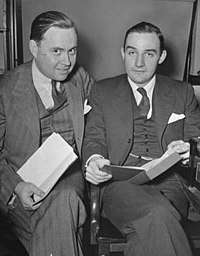Turner Catledge
William Turner Catledge (/ˈkætlɪdʒ/; 1901–1983) was an American journalist, best known for his work at The New York Times. He was managing editor from 1952 to 1964, when he became the paper's first executive editor.[1]

After retiring in 1968, he served briefly on the board of The New York Times company as a vice president. He published his autobiography, My Life and The Times, in 1971.
Early life
Catledge was born on March 17, 1901 to his parents, Lee Johnston Catledge and Willie Anna Turner, and older sister Bessie Lee Catledge, on his grandfather’s 900-acre (3.6 km2) farm in Ackerman, Mississippi.[2] When he was three, his family moved to Philadelphia, Mississippi. After graduating from Philadelphia High School in 1918, he enrolled at Mississippi A&M with a science major.
Career in journalism
Catledge's first news job was at fourteen years old for the Neshoba Democrat, setting type. After college, the Democrat offered him another job but instead he became editor of the Tunica Times (Tunica, Mississippi) in 1922, and later managing editor and mechanical superintendent of the Tupelo Journal (Tupelo, Mississippi). At the Journal he campaigned against the Ku Klux Klan, who were most active during this time period; in response, the Klan burned down the newspaper plant.[3]
After Catledge lost his job due to the Tupelo Journal incident, he moved to Memphis, Tennessee; there, he worked for The Commercial Appeal, the city's daily newspaper.
Finally, in the spring of 1929, Catledge began working at The New York Times, starting in the New York bureau, until later when he began work in the company's Washington, D.C. bureau as a reporter covering the U.S. House of Representatives.
In the winter of 1941, he left the New York Times to become chief correspondent and later Editor-in-Chief of the Chicago Sun. In 1943, he was rehired by The New York Times as a national correspondent.[4]
Over the remainder of his career, he worked for the Times as managing editor, executive editor, and last as the company's vice president.
Family life
On March 19, 1931, Catledge married Mildred Turpin, with whom he had two children, Mildred Lee in 1932, and Ellen Douglas in 1936. They married at the Church of the Transfiguration in New York. In 1949, Catledge and wife Mildred divorced; he married his second wife, widow Abby Ray Izard, in December 1957.
Catledge was a first cousin of the New Orleans-based journalist Iris Turner Kelso.[5]
Death
Turner Catledge died in 1983, age 82.
In literature
- The Broadway play The Girls in 509 by author Howard M. Teichmann was dedicated to Turner Catledge.[6]
References
- "Clifton Daniel Given Promotion". Janesville Daily Gazette. Janesville, Wisconsin. 4 Sep 1964. p. 1. Retrieved 23 June 2015 – via Newspapers.com.
- "Turner Catledge: Information from Answers.com". Columbia Encyclopedia. Answers.com. Retrieved 2009-11-09.
- "Turner Catledge, Mississippi writer". Mississippi Writers and Musicians. Retrieved 2009-11-09.
- Talese, Gay, "The Kingdom and the Power" p. 44, 197-198
- "Iris Turner Kelso". beta.wpcf.org. Retrieved October 13, 2013.
- Howard Teichmann (1959). The Girls in 509: A Comedy in Two Acts. Samuel French, Inc. p. 5. ISBN 978-0-573-60940-4. Retrieved July 20, 2012.